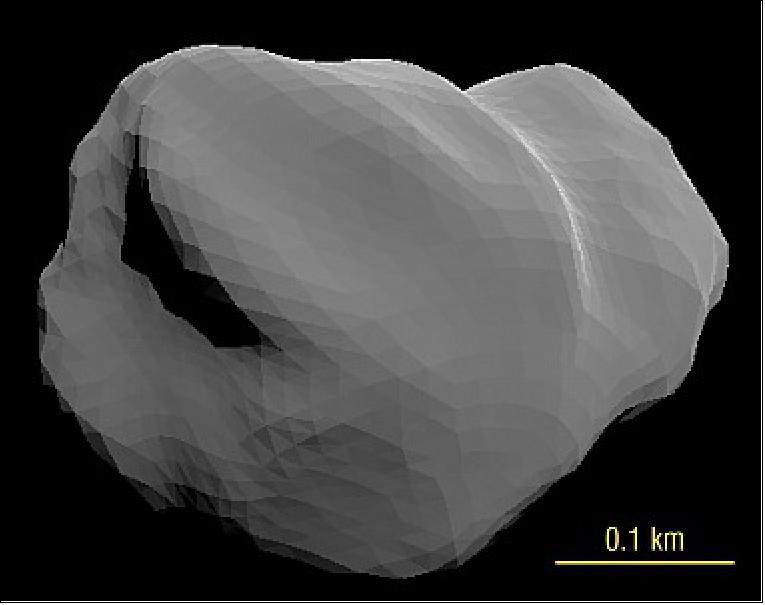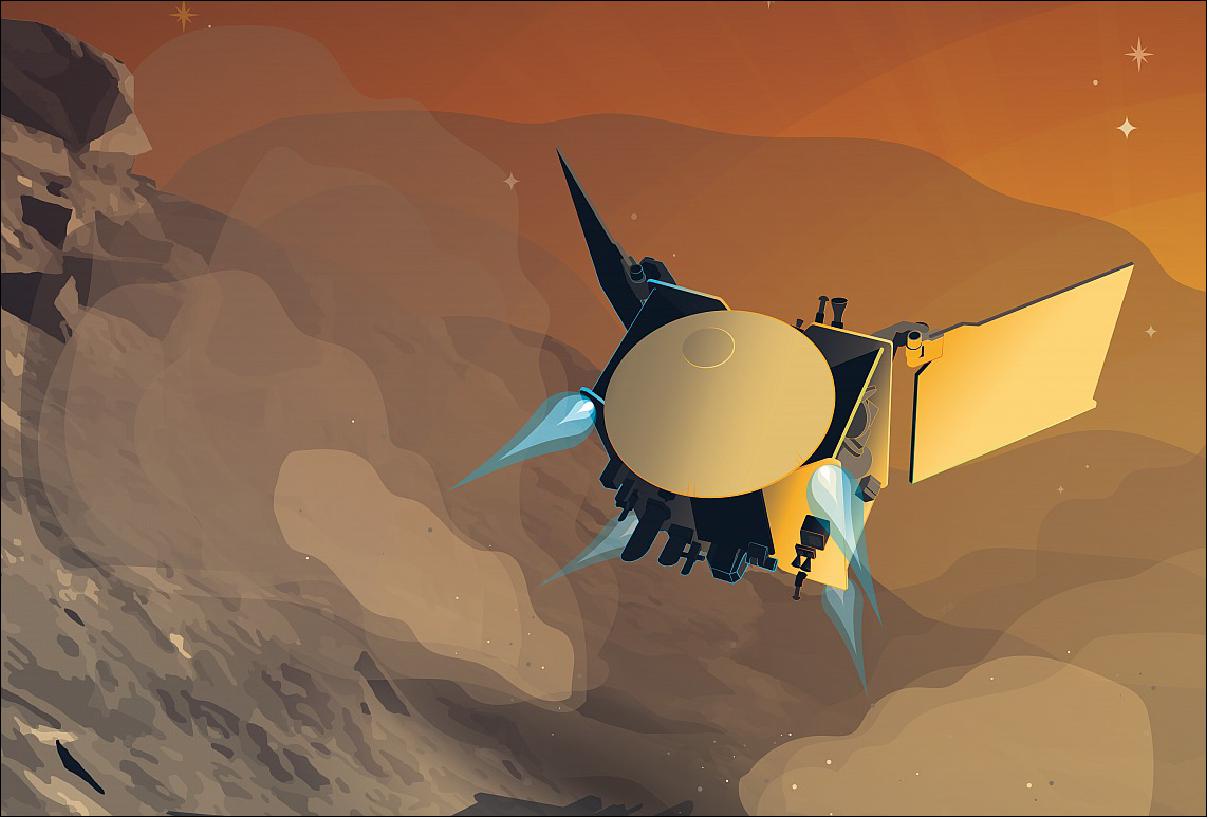OSIRIS-APEX (Origins, Spectral Interpretation, Resource Identification, and Security-APophis EXplorer)
Non-EO
NASA
Exploration
Quick facts
Overview
| Mission type | Non-EO |
| Agency | NASA |
OSIRIS-APEX (Origins, Spectral Interpretation, Resource Identification, and Security-APophis EXplorer)
A NASA mission to return samples from one near Earth asteroid will get an extended mission to visit a second asteroid under a plan approved by the agency 25 April 2022. 1)
NASA announced that the OSIRIS-REx (Origins, Spectral Interpretation, Resource Identification, Security-Regolith Explorer) spacecraft, on its way back to Earth after collecting samples from the asteroid Bennu, will travel to the asteroid Apophis after returning samples in September 2023.

The main spacecraft, after ejecting the sample return container that will land in the Utah desert, will fly by Earth on a trajectory that will bring it to Apophis in 2029, shortly after that asteroid passes just 32,000 km from the Earth. The spacecraft will spend 18 months in the vicinity of Apophis, studying the 350-meter asteroid and coming close enough to use its thrusters to brush away surface rocks and expose subsurface materials.
Apophis has long been an asteroid of interest to planetary scientists because of its close approaches to Earth in 2029 and 2036 that, for a time after its discovery, raised concerns about an impact. While scientists have ruled out an impact, the close approach offered the prospect of spacecraft missions to study the asteroid, something the OSIRIS-REx mission team had been discussing since 2020.
“Apophis is one of the most infamous asteroids,” said Dani DellaGiustina, deputy principal investigator for OSIRIS-REx, in a statement. She will become principal investigator of the extended mission, called OSIRIS-APEX for “Apophis Explorer,” after the Bennu samples are returned to Earth. “We were stoked to find out the mission was extended.”
Scientists will use the extended mission to study the composition of the asteroid as well as determine if the asteroid’s structure was affected by the close Earth flyby. The project estimates the extended mission will cost $200 million over nine years.
“The investigation is not without substantial technical risk,” Lori Glaze, director of NASA’s planetary science division, wrote in an April 25 memo approving the extension. The trajectory OSIRIS-APEX will take will bring it within half an astronomical unit of the sun, much closer than originally designed when the spacecraft traveled to Bennu, requiring what she called “significant engineering work” to ensue spacecraft systems can survive several such close approaches before arriving at Apophis.
OSIRIS-REx was one of eight planetary science missions that won extensions after a “senior review” of spacecraft that had already completed their primary missions. NASA extended the other seven missions — Curiosity, InSight, Lunar Reconnaissance Orbiter, Mars Odyssey, Mars Reconnaissance Orbiter, MAVEN and New Horizons — by three years each.
NASA extended the InSight Mars lander despite expectations that declining output from its solar arrays will cause the mission to end later this year, before the extended mission can begin. A report from the panel that conducted the senior review noted the project gives the spacecraft only a 5% chance of surviving through the end of this year, with the expectation that, by December, power levels drop to a level called “dead bus recovery” (DBR) mode that render the spacecraft inoperable.
The extended mission, though, would allow the possibility for some spacecraft operations if the spacecraft can revive itself in the next Martian summer in mid-2023. “If the spacecraft can ‘resurrect’ itself from DBR after depth of winter,” the report stated, “system operability would need to be determined at the time” to see if an extended mission was feasible.
NASA is also closely monitoring fuel levels on Mars Odyssey, a spacecraft operating at more for more than two decades. The overall spacecraft is “remarkably healthy,” the senior review report stated, but uncertainty about how much fuel is left on the spacecraft raises questions about how long it can continue to operate to both conduct science and serve as a communications relay for other Mars missions.
Other than OSIRIS-REx, NASA did not disclose the cost of extended missions. NASA’s fiscal year 2023 budget proposal projected spending between $7.8 million, on InSight, and $45 million, on the Curiosity Mars rover that year. Glaze wrote in her memo that for New Horizons, projected to spend $12.5 million in 2023, she would look to share costs with the agency’s astrophysics and heliophysics divisions because of the science that distant spacecraft would perform in its extended mission.
Mission Status
• April 25, 2022: The extended mission, dubbed OSIRIS-APEX, will study the near-Earth asteroid Apophis, which will have a close encounter with Earth in 2029. 2)
- NASA's OSIRIS-REx spacecraft will swing by Earth to deliver a sample from asteroid Bennu on Sept. 24, 2023. But it won't clock out after that.
- NASA has extended the University of Arizona-led mission, which will be renamed OSIRIS-APEX, to study near-Earth asteroid Apophis for 18 months. Apophis will make a close approach to Earth in 2029.
- The University of Arizona will lead the mission, which will make its first maneuver toward Apophis 30 days after the OSIRIS-REx spacecraft delivers the sample it collected from Bennu back in October 2020. At that point, the original mission team will split – the sample analysis team will analyze the Bennu sample, while the spacecraft and instrument team transitions to OSIRIS-APEX (OSIRIS-Apophis Explorer).
- Regents Professor of Planetary Sciences Dante Lauretta will remain principal investigator of OSIRIS-REx through the remaining two-year sample return phase of the mission. Planetary sciences assistant professor and OSIRIS-REx deputy principal investigator Dani DellaGiustina will then become principal investigator of OSIRIS-APEX. The extension adds another $200 million to the mission cost cap.
- The mission team did an exhaustive search for potential asteroid targets. The OSIRIS-REx spacecraft was built for what's called a rendezvous mission, meaning instead of making a single flyby of an object and quickly snapping images and collecting data, it was designed to "get up close and personal with the object." DellaGiustina said. "Our spacecraft is really phenomenal at that."

- "Apophis is one of the most infamous asteroids," DellaGiustina said. "When it was first discovered in 2004, there was concern that it would impact the Earth in 2029 during its close approach. That risk was retired after subsequent observations, but it will be the closest an asteroid of this size has gotten in the 50 or so years asteroids have been closely tracked, or for the next 100 years of asteroids we have discovered so far. It gets within one-tenth the distance between the Earth and moon during the 2029 encounter. People in Europe and Africa will be able to see it with the naked eye, that's how close it will get. We were stoked to find out the mission was extended."
- OSIRIS-REx was launched in 2016 to collect a sample from Bennu that will help scientists learn about the formation of the solar system and Earth as a habitable planet. OSIRIS-REx is the first NASA mission to collect and return a sample from a near-Earth asteroid.
- OSIRIS-APEX will not collect a sample, but when it reaches Apophis, it will study the asteroid for 18 months and collect data along the way. It also will make a maneuver similar to the one it made during sample collection at Bennu, by approaching the surface and firing its thrusters. This event will expose the asteroid's subsurface, to allow mission scientists to learn more about the asteroid's material properties.
- The scientists also want to study how the asteroid will be physically affected by the gravitational pull of Earth as it makes its close approach in 2029.
- They also want to learn more about the composition of the asteroid. Apophis is about the same size as Bennu – nearly 1000 feet at its longest point – but it differs in what's called its spectral type. Bennu is a B-type asteroid linked to carbonaceous chondrite meteorites, whereas Apophis is an S-type asteroid linked to ordinary chondrite meteorites.
- "The OSIRIS-REx mission has already achieved so many firsts and I am proud it will continue to teach us about the origins of our solar system," said University of Arizona President Robert C. Robbins. "The OSIRIS-APEX mission extension keeps the University of Arizona in the lead as one of the premier institutions in the world to study small bodies with spacecraft and demonstrates again our incredible capacity in space sciences."
- DellaGiustina is also excited that the mission provides an excellent opportunity for early career scientists to gain professional development. OSIRIS-REx veterans will work closely with these early career scientists as mentors in the early mission phases. By the time the spacecraft arrives at Apophis, the next generation will step into leadership roles on OSIRIS-APEX.
- "OSIRIS-APEX is a manifestation of a core objective of our mission to enable the next generation of leadership in space exploration. I couldn't be prouder of Dani and the APEX team," Lauretta said. "Dani first started working with us in 2005 as an undergraduate student. To see her take on the leadership of the mission to asteroid Apophis demonstrates the outstanding educational opportunities at the University of Arizona."

References
1) Jeff Foust, ”NASA to repurpose OSIRIS-REx for second asteroid encounter,” SpaceNews, 26 April 2022, URL: https://spacenews.com/nasa-to-repurpose-osiris-rex-for-second-asteroid-encounter/
2) Mikayla Mace Kelley, ”NASA gives green light for OSIRIS-REx spacecraft to visit another asteroid,” University of Arizona News, 25 April 2022, URL: https://news.arizona.edu/story/nasa-gives-green-light-osiris-rex-spacecraft-visit-another-asteroid
The information compiled and edited in this article was provided by Herbert J. Kramer from his documentation of: ”Observation of the Earth and Its Environment: Survey of Missions and Sensors” (Springer Verlag) as well as many other sources after the publication of the 4th edition in 2002. - Comments and corrections to this article are always welcome for further updates (eoportal@symbios.space).